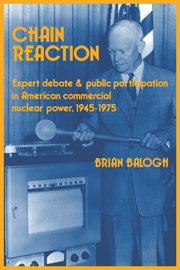 Chain Reaction
Chain Reaction Book contents
- Frontmatter
- Contents
- Acknowledgments
- List of abbreviations
- 1 From fission to fusion: professionalization and politics in twentieth-century America
- 2 The promise of the proministrative state: nuclear experts and national politics, 1945–1947
- 3 Forging an iron triangle: the politics of verisimilitude
- 4 Triangulating demand: the Atomic Energy Commission's first decade of commercialization
- 5 The centrifugal push of expertise: reactor safety, 1947–1960
- 6 The magnetic pull of professional disciplines, issue networks, and local government
- 7 Nuclear experts on top, not on tap: mainstreaming expertise, 1957–1970
- 8 Nuclear experts everywhere: the challenge to nuclear power, 1960–1975
- 9 Conclusion: harnessing political chain reactions
- Index
2 - The promise of the proministrative state: nuclear experts and national politics, 1945–1947
Published online by Cambridge University Press: 07 May 2010
- Frontmatter
- Contents
- Acknowledgments
- List of abbreviations
- 1 From fission to fusion: professionalization and politics in twentieth-century America
- 2 The promise of the proministrative state: nuclear experts and national politics, 1945–1947
- 3 Forging an iron triangle: the politics of verisimilitude
- 4 Triangulating demand: the Atomic Energy Commission's first decade of commercialization
- 5 The centrifugal push of expertise: reactor safety, 1947–1960
- 6 The magnetic pull of professional disciplines, issue networks, and local government
- 7 Nuclear experts on top, not on tap: mainstreaming expertise, 1957–1970
- 8 Nuclear experts everywhere: the challenge to nuclear power, 1960–1975
- 9 Conclusion: harnessing political chain reactions
- Index
Summary
That World War II and the ensuing cold war heated up the courtship between professionals and the federal government does not mean that external factors alone accounted for the new symbiotic relationship that emerged by 1950 – what I have called the “proministrative state.” The foundation had been laid in the interwar years. In the Progressive Era, four barriers prevented the flirtation from being consummated. By the eve of World War II, two of these obstacles had almost been surmounted.
Immaturity was the first to fall. In organizational terms, maturity could be measured by “state capacity.” In profession-building terms, it could be measured by professional autonomy. The interwar years were a crucial period of parallel development for both the professions and the federal government. The millions of dollars poured into professional development by the voluntary sector and the growth of American research universities nurtured the professions in both the physical and social sciences. The crises of World War I, the Great Depression, and America's role as an economic world power enhanced the federal government's capacity to administer complex programs. Both the professions and the federal government matured in fits and starts. Particularly in the public sector, rapid expansion was often followed by even swifter demobilization. The professions developed more unevenly: those grounded in the physical sciences advanced faster than those drawing on the social sciences.
- Type
- Chapter
- Information
- Chain ReactionExpert Debate and Public Participation in American Commercial Nuclear Power 1945–1975, pp. 21 - 59Publisher: Cambridge University PressPrint publication year: 1991


